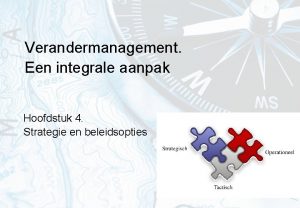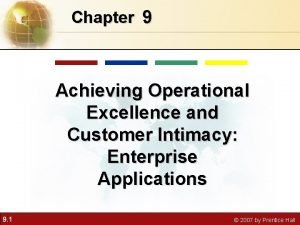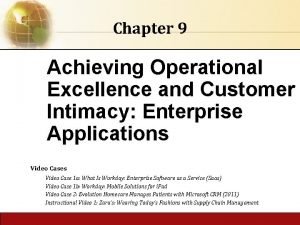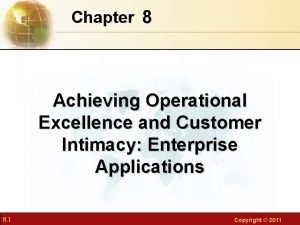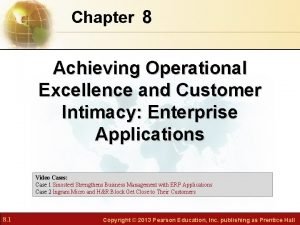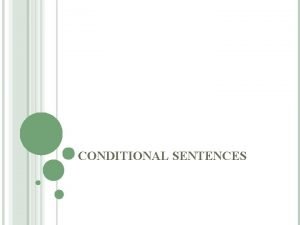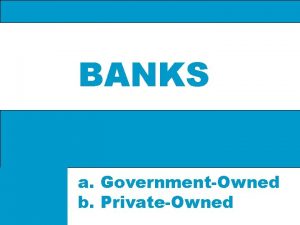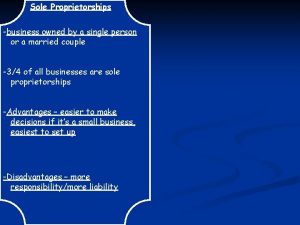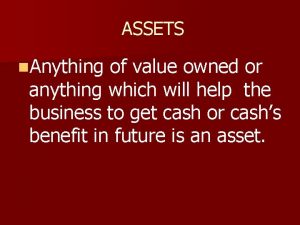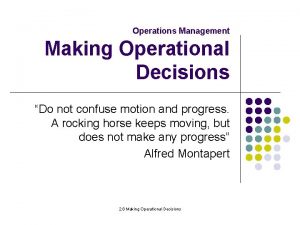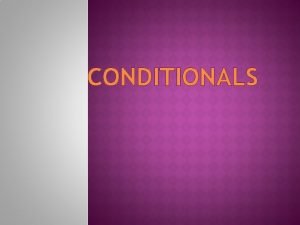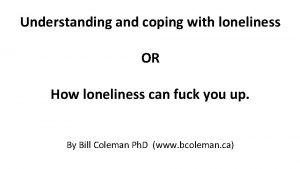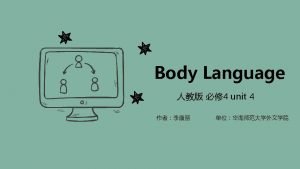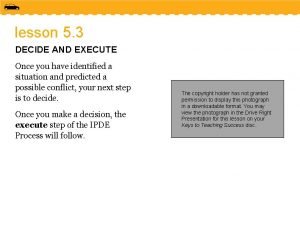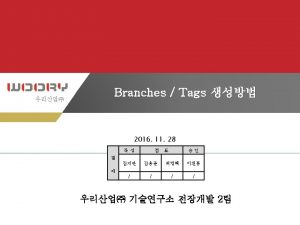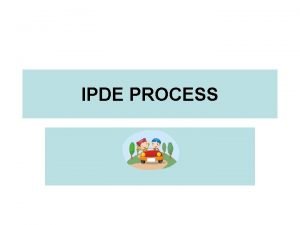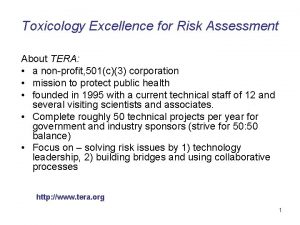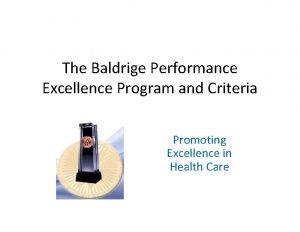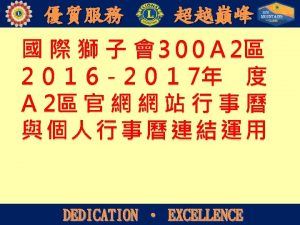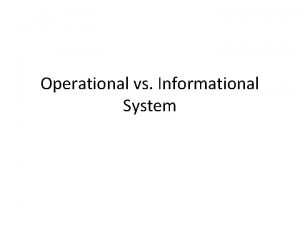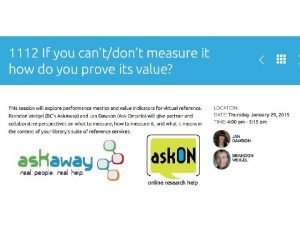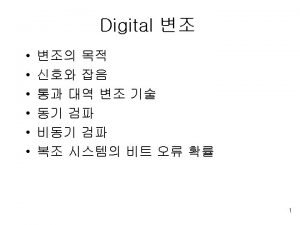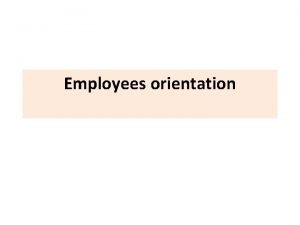Operational Excellence Ask your employees If you owned





























































- Slides: 61

Operational Excellence “Ask your employees… If you owned this company what would you do to improve it? ” Jack Simms, The idea generator

Plan-Do-Check-Act Problem-Solving Process and Using the A 3 Template for Problem Identification +

Agenda Introduction / background Exercise 1: what do you “see”? PDCA Cycle Problem solving tools Exercise 2: Group Dynamics A 3 Report Exercise 3: Problem Statement Exercise 4: Group Practical Exercise 3

Background: Features and Benefits PDCA & A 3 problem-solving are tools which: 1. Efficiently lead to the identification of a root cause, 2. Evaluate various candidate countermeasures that can be applied to mitigate a problem. 3. When practically applied, PDCA can guide a person or organization as they • Define the root cause of a problem, • Build consensus and support among stakeholders • Capture and communicate the resulting actions and decisions and their logic.

Background: Features & Benefits When an organization understands Problem-solving principles: Move FROM: fire-fighting culture TO: individual responsibility in solving problems at their root cause, sharing & Organizational Learning When fully adopted, Individuals distinguish symptoms from root causes so they can effectively analyze problems and evaluate countermeasures. ► Cross-functional groups begin capturing the knowledge generated while solving a problem ► Communicate learning to appropriate colleagues and management. ►

Let’s see how you “see”

Exercise 1: It’s all in the details! From memory, draw the front side of a penny …include all of the details 10 minutes

Teacher’s Key: Every Detail Correct: +1 point Every Detail Missed /Wrong: - 1 point: Face Facing? : Left or Right Left = -1 RIGHT = +1 “USA? ”: YES = -1 “E Pluribus Unum? ”: YES = -1 “In God We Trust? ”: Yes = +1 Location: “I. G. W. T? ”: Top = +1 Anywhere else= -1 Date? : No = -1 Yes = +1 Date Location? Left = -1 Bottom Right = +1 Mint Letter: None = -1 Yes = +1 Mint Location: Left = -1 Under date: = +1 “One cent”: Yes = -1 No = +1 “Liberty? ”: No = -1 Yes = +1 Liberty Location: Right = -1 Left = +1 “What we know” and “what we think we know” are two very different things…

“Seeing” Problems People come to work to add value but often don’t see the details to make the job easier…

Identifying a Problem “problems are golden nuggets” Define: What is the problem; what is the pain? ► How does it make your job difficult? ► Why does it matter? ► Who does it affect / does not affect. ► What does it effect / does not affect. ► How does it effect / does not affect. ► When is it a problem / is not a problem. ► Where is it a problem / is not a problem. How will we know that a change is an improvement? What change will we make that will result in an improvement?

PDCA Steps Step 1: (Hypothesis) “Plan” ► Identify problem ► Investigate root cause ► Select appropriate countermeasures Step 2: (Try) “Do” ► Implement countermeasures Step 3: (Reflect) “Check” ► Study the Results Step 4: (Adjust/) “Act” ► Standardize and Plan Continuous Improvement

Step 1 A: “Plan” Problem Identification 1. Determine the problem area 2. Define the standard 3. Define the current situation 4. Determine the inconsistency 5. Select a measurable goal 6. State the problem in a “Problem Statement” form in order to brainstorm potential causes

Step 1 B: “Plan” Cause Investigation 1. Brainstorm potential causes of the problem 2. Collect and analyze data related to the problem 3. Challenge the data with facts 4. Select most likely causes 5. Establish a cause/effect relationship 6. Determine root/driver cause

Step 1 C: “Plan” Select Countermeasures 1. Brainstorm for countermeasures to address root cause 2. Select proper countermeasure based upon criteria 3. Coordinate/gain approval of leadership to implement countermeasure

Step 2: “Do” Implement Countermeasures 1. Develop a plan to implement the countermeasure(s) selected 2. Are they temporary? 3. Assign tasks 4. Communicate the plan 5. Execute pilot Implementation Plan with timelines and establish a tracking method

Step 3: “Check” Study the Results 1. Monitor progress of pilot Implementation Plan 2. Gather/analyze additional data if necessary 3. Modify implementation plan if necessary, based upon results 4. Monitor results of the specific countermeasure(s) that addressed the root cause

Step 4: “Adjust / Act” Standardize and improve 1. Evaluate the results 2. Standardize the effective countermeasure(s) to prevent recurrence 3. Share success with other affected areas 4. Plan on-going monitoring of the solution 5. Start the PDCA process again to refine the countermeasure or if the results are uneven 6. Continue with other improvement opportunities

Step 5: “Continuous Improvement”!

Summary of PDCA Steps Handout

Group Dynamics Exercise 2 5 Brain Teasers: How successful solving by yourself? How successful solving as a Team?

Tools for Step 1 A: Problem Identification Tools to clarify information for problem identification: ►Check sheet ►Line graph ►Pareto Chart ►Flowchart ►Affinity diagram Keep? Omit? Or move to X?

Tools for Step 1 B: Cause Investigation Tools to identify the most likely causes of the problem: ►Cause and Effect (Fishbone) diagram ►Affinity diagram Keep? Omit? ►Interrelationship diagram Or move to X?

Tools for Step 1 C: Select Countermeasures Tools to select countermeasures: ►Criteria matrix ►Force field analysis Keep? Omit? Or move to X?

Tools for Step 2: Implement Countermeasures Tools to implement countermeasures: ►Implementation Plan / Gantt chart ►Action Plans ►Flowchart Keep? Omit? Or move to X?

Tools for Step 3: “Check” Study the Results Tools for determining effectiveness of countermeasures: ►Data collection ►Check sheet ►Line graph ►Histogram ►Pareto ►Flowchart Keep? Omit? Or move to X?

Tools for Step 4: “Adjust / Act” Standardize Tools for planning and implementing standardized processes: ►SOPs ►Visual Controls ►Force field analysis ►Criteria matrix ►Radar chart ►Flow chart Keep? Omit? Or move to X?

Tools for Problem Solving • 5 W-1 H • Cause and effect diagram (Fishbone Diagram) • Pareto chart • Flowchart

5 -Why + (1 -How) Analysis The 5 ‘Whys’ and 1 ‘How’ Define the problem ► What fails? ► Where does the failure occur? ► When does it occur? ► How does it occur Then ask ‘why’ five times until root cause(s) are identified or ignorance is reached Once the root cause(s) is identified, ask, ‘How do I correct it? ’ PDCA 1/07

5 Why Analysis Cons: tion: dentifica I m le b re? o Pr lem/failu b o r p e h cur? What’s t oes it oc d e r e h W ur? es it occ When do t occur? s i How doe Pros: East to use Introduces problem solving methods Prevents band-aid solutions (rush to judgment) Stakeholders not always involved Not data driven, not repeatable Easy to bias results. . . Relies on personal experience. . . -go and investigate. . . go and see Doesn't account for multiple cause factors Non-date analysis of simple issues, -important problems need data analysis How?

5 -Whys Exercise To be refined Habitually late for work: Why is the employee late? Because she woke up late. Why did she wake up late? Because she slept late last night. Why did she stay up too late? Because she watched a late night show on TV. Why did she watch TV late in the night? Because she can’t sleep. Why can’t she sleep? Because she has insomnia. Why is she insomniac? Because she is worrying. Why is she worried? Because she’s thinking that she might lose her job. Why is she worried of losing her job? Because she’s not getting any feedback from her boss regarding her work. Keep? Omit? Or move to X?

Tools for Problem Solving • 5 W-1 H • Cause and effect diagram (Fishbone Diagram) • Pareto chart • Flowchart

Fishbone Diagram (Ishikawa diagram) Problem-Solving Analysis Instructions Cause Effect Refer to the Toolkit

Fishbone Diagram Problem-Solving Analysis Instructions Materials Measurements Test results Vendor-supplied Attention Age Process Temperature People (Manpower) Training Recipe / VC Work Balance Strength Skills Contamination Technique Calibration Humidity Machine Temp Order of work Ambient Temp Settings Timing Environment Accuracy Adjustments Reliability Methods Cause Equipment (Machines) Effect

Simches 5 -Whys Example

Creating a Fishbone Diagram Step 1: Clarify the characteristics of the problem and write a title Step 2: Write in the effect characteristics and draw the spine Step 3: Clarify the factors affecting the characteristics Step 4: Check for omitted factors Step 5: Identify factors that strongly affect the characteristic Step 6: Write in related information

Tools for Problem Solving • 5 W-1 H • Cause and effect diagram (Fishbone Diagram) • Pareto chart • Flowchart

Pareto Charts Used to show relative frequency or magnitude of events or issues, to identify the most important.

Creating a Pareto Chart Step 1: Decide which items to study and collect data ► Content categories ► Cause categories ► Select the data collection time period Step 2: Tabulate data and calculate the cumulative number ► Arrange items in order ► Use of “Other” category

Creating a Pareto Chart Step 3: Draw the vertical and horizontal axes Step 4: Display the data as a bar graph Step 5: Drawing a cumulative curve Step 6: Create a percentage scale on a vertical axis on the right side Step 7: Label the diagram Step 8: Examine the diagram

Tools for Problem Solving • 5 W-1 H • Cause and effect diagram (Fishbone Diagram) • Pareto chart • Flowchart

PDCA + A 3 = Model for Improvement + = PDCA + A 3 = Model for Improvement 1) “What are you trying to accomplish? 2) “How will we know that a change is an improvement? 3) What change can we make that will result in an improvement?

A 3 or Mini-Kaizen Problem-solving Storyboard: “A 3” Hand-written Simple and easy to read / relate to Dynamic

“P” “D” “C” “A” Title / A 3 Theme: Owner: Problem Statement: Of all our problems, why this one? “P” Current Situation: What do we know for sure? “P” Date: Stakeholders: Recommendations: What are your proposed countermeasures, strategies, alternatives? “D” Implementation Plan What activities will be required? What? Who? “C” When? Goal: What is the specific change we want to accomplish now? “P” Root-cause Analysis: What are the causes, requirements, constraints? “P” Follow-Up Actions: What issues remain? Approval: How will they be addressed? Have all appropriate steps and departments been involved in this project? Yes / No “A”

A-3 Report – Administrative Data Title of project Name, title, date Team / stakeholders Approval Authorities

Problem Description Statement The Issue / Problem ► Sounds easy; the most difficult ► What REALLY is the problem? What is the REAL PAIN the Team is experiencing? ► Leaders may need to coach and “mentor” the problemsolver to revisit the problem as the progress through the Mini Kaizen and start analyzing the real problem!

A Good “Problem Statement” test: • What is the problem? • Why is it a problem? • How important is it? (how does it tie to the CCM business objectives/Mission Statement) • How can you measure the problem? • What are the FACTS?

Exercise 3: Problem Statement Escalator Video http: //www. youtube. com/watch? v=47 r. Qk TPWW 2 I ►Materials ►Manpower ►Methods ►Mother Nature ►Machines ►Measure

Current Situation • Determine the Problem ► Background ► Context ► Business of issue impact • Standard • Current Situation or Performance • Discrepancy – Current versus Ideal • Extent or Duration • Rationale (Reason to Improve) • Goal Statement

Goal • What is the specific change we want to accomplish now? • What is the ideal state? • What will a “perfect” situation look like? • Does this goal support the CCM Mission? • Has leadership approved of the Goal?

Identifying Causes and Solutions • Problem Statement ► Revisit & review • 5 -Whys • Potential Causes • After Fishbone Categorization • Analyze Root Causes • Prioritize • Countermeasure(s) Brainstormed

Solutions / Countermeasures • Countermeasures selected • How will they eliminate root causes? • How will we communicate the countermeasures? • How will we monitor the countermeasures?

Implementation Plan • What will be done? • Who will do? • Where will it be done? • By when will it be done?

Following Up • What will be checked? • How will it be checked? • When will it be checked? • What next steps are recommended? ►New improvement? ►New problem?

A 3 Group Exercise 4: Titanic (or next slide)

A 3 Group Exercise 4: “Poor Alice” Team Lead candidate Attendance issues: corrective action Competing priorities Family dynamics Household flow

JDIs: (…failure to plan is planning to fail…) Proceed with Caution! “PDCA is destroyed in the reverse order it is built…” Beware of justifying a solution without analyzing the problem… Leaders should ask: What problem are they trying to solve? Did they test / document it? How will they know the condition improved?

Mini-Kaizen / JDI Plaque • Recognize improvements • Track Improvements • Stimulate TEE involvement

Feedback? What made sense? What needs more clarification? How will you use PDCA / A 3? When will you use PDCA / A 3?

Extra Slides

Problem Solving Methods & Tools Coaching ► Campus managers ► Facility managers ► Program managers Observation ► Data collection Brainstorming ► All Roles VSM ► Flow Charts 5 Whys Fishbone Diagram

PDCA cycle Problem-Solving Model Adjust / Act Hypothesis Reflect Try “Scientific Method”
 If your instructor were to ask if you cleaned up your room
If your instructor were to ask if you cleaned up your room Checklist verandermanagement
Checklist verandermanagement Digital operational excellence
Digital operational excellence Achieving operational excellence and customer intimacy
Achieving operational excellence and customer intimacy Operational excellence customer intimacy
Operational excellence customer intimacy Operational excellence
Operational excellence Operational excellence
Operational excellence Operational excellence
Operational excellence Operational excellence
Operational excellence What food do you like answer
What food do you like answer Pendleton feedback model
Pendleton feedback model 10 examples of zero conditional sentences
10 examples of zero conditional sentences The zero conditional sentences
The zero conditional sentences When you buy eggs you usually ask for a
When you buy eggs you usually ask for a Put your right foot in
Put your right foot in You say you love rain
You say you love rain Family health project
Family health project Ask your classmate
Ask your classmate Answer the questions where is kate
Answer the questions where is kate Family-owned and operated
Family-owned and operated Octopus yacht position
Octopus yacht position Pros and cons of greenfield investment
Pros and cons of greenfield investment Bank owned aircraft
Bank owned aircraft Government owned bank
Government owned bank Is chapstick owned by pfizer
Is chapstick owned by pfizer Resources owned by a business are referred to as
Resources owned by a business are referred to as A business owned by one person
A business owned by one person For the first time in forever music
For the first time in forever music Fed rothschild
Fed rothschild Owned goods examples
Owned goods examples Anything of value owned by a business
Anything of value owned by a business Operational decisions: bump up your bumper
Operational decisions: bump up your bumper Perhaps one day a millionaire will ask you to marry him her
Perhaps one day a millionaire will ask you to marry him her Whatsoever he saith do it
Whatsoever he saith do it You may ask yourself chapter 8
You may ask yourself chapter 8 30 interview questions you can't ask
30 interview questions you can't ask If you could ask jesus one question
If you could ask jesus one question Give us your hungry your tired your poor
Give us your hungry your tired your poor Accept your loneliness you are your only friend
Accept your loneliness you are your only friend Be reconciled to your brother
Be reconciled to your brother The way you see your body is your
The way you see your body is your Sore boobs early pregnancy
Sore boobs early pregnancy Slogan de sprite
Slogan de sprite You are good you are good and your love endures
You are good you are good and your love endures What is your name and how old are you
What is your name and how old are you Hapi nod
Hapi nod Did you finish your assignment
Did you finish your assignment You separate hazards when you adjust your
You separate hazards when you adjust your If type 3
If type 3 Moving and lifting of the patient
Moving and lifting of the patient Wheeled ambulance stretcher
Wheeled ambulance stretcher Straddle slide technique
Straddle slide technique Thank you any question
Thank you any question Compromise space
Compromise space Split speech example
Split speech example You take $100 you had kept
You take $100 you had kept Eat meals that are nutritious agree or disagree
Eat meals that are nutritious agree or disagree If you think you can you can poem
If you think you can you can poem Tell me what you eat and i shall tell you what you are
Tell me what you eat and i shall tell you what you are I will follow you wherever you blank
I will follow you wherever you blank Tera toxicology
Tera toxicology Baldrige performance excellence program
Baldrige performance excellence program

